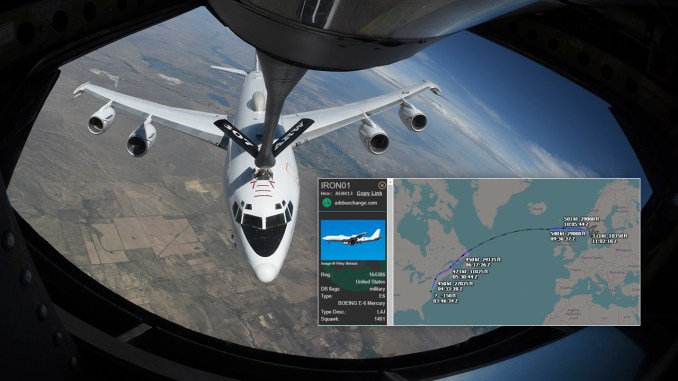
receiving fuel from a KC-135R Stratotanker over Colorado on Aug. 23, 2019. Inset: Flight
path of IRON 01 from Pax River to Rygge, Norway. (Image credit: U.S. Air Force
photo/Greg L. Davis & ADS-B Exchange)
A U.S. Navy E-6B Mercury communications relay and strategic airborne command post aircraft deployed overnight on June 20, 2024 to Rygge Air Force Base in Norway.
The flight from Naval Air Station Patuxent River, commonly known as Pax River, was spotted quickly by flight tracking enthusiasts. Using the callsign IRON 01, a squadron callsign for Fleet Air Reconnaissance Squadron 3 (VQ-3), nicknamed the Ironmen, the aircraft took a standard route east across the Atlantic Ocean to the Norwegian base, located close to the border with recent NATO recruit Sweden.
Earlier this morning, US Navy E-6B Mercury #AE0413 as IRON01 departed from NAS Pax River, MD and arrived in Rygge, Norway.
This is the first deployment to Norway that I’ve seen. Heading to the Arctic? pic.twitter.com/YICyABfxLO
— TheIntelFrog (@TheIntelFrog) June 20, 2024
Deployments to Europe are not uncommon for the Boeing 707-based E-6B Mercury fleet, usually making an appearance at least once or twice per year for training exercises. On many occasions the aircraft would be seen at Stuttgart Airport in Germany close to the headquarters of United States European Command (EUCOM) and United States Africa Command (AFRICOM), or at RAF Mildenhall in the United Kingdom where an E-6B notably deployed in 2011 during Operation Neptune Spear.
This does however appear to be the first time an E-6B has deployed to Norway. The use of Rygge itself is notable, as it is one of the bases chosen to receive American investment for use by U.S. and other NATO forces. During Exercise Nordic Response 24 earlier in the year, Rygge hosted two NATO E-3A Sentry AWACS aircraft.
According to a NOTAM, formerly known as Notice to Airmen, now termed a Notice to Air Missions (FAA) or Notice to Aviation (UK CAA), listed for the Norway flight information region (FIR) an area of airspace has been designated for military operations, and warning of an invisible flight hazard, off the Western coast of Norway on June 23, 2024.
🇺🇸E-6B airborne command post landed this morning at Ryyge Air Base in 🇳🇴Norway.
The aircraft main mission is relaying ☢️ launch order toward submarines (SSBN) at sea using ~8km long VLF antenna
A NOTAM consistent with this type of mission will be active off … pic.twitter.com/7BRhaUXrPy
— Etienne Marcuz (@M51_4ever) June 20, 2024
This type of NOTAM is consistent with those commonly used to cover E-6B missions involving the deployment of one of the aircraft’s two trailing wire antennas. With the longest wire reaching up to five miles, or eight kilometers, in length, they are deployed while the aircraft flies a tight spiral pattern, leading to the wire to droop almost vertically down towards the sea. The aircraft can then broadcast radio transmissions in the very low frequency (VLF) range to communicate with submerged submarines at a considerable distance.
One of the trailing wires can be seen on the exterior of the aircraft, with the drogue sticking out from the tailcone. This is the secondary, shorter antenna. The primary antenna is located behind a hatch in the underside of the fuselage towards the rear of the jet, which opens to deploy the wire.
An E-6B being handed back to the U.S. Navy by Northrop Grumman following upgrade works. Both trailing wires are visible in this photograph, with the secondary antenna at the very rear of the tail and the primary antenna hatch open on the fuselage. (Image credit: Northrop Grumman)
” data-medium-file=”https://i0.wp.com/theaviationist.com/wp-content/uploads/2024/06/E6_NorwayDeployment_2.jpg?fit=460%2C307&ssl=1″ data-large-file=”https://i0.wp.com/theaviationist.com/wp-content/uploads/2024/06/E6_NorwayDeployment_2.jpg?fit=706%2C470&ssl=1″ class=”size-large wp-image-87104″ src=”https://zephyrnet.com/wp-content/uploads/2024/06/u-s-navy-e-6b-mercury-airborne-command-post-makes-rare-deployment-to-norway-1.jpg” alt width=”706″ height=”470″ srcset=”https://zephyrnet.com/wp-content/uploads/2024/06/u-s-navy-e-6b-mercury-airborne-command-post-makes-rare-deployment-to-norway-1.jpg 706w, https://zephyrnet.com/wp-content/uploads/2024/06/u-s-navy-e-6b-mercury-airborne-command-post-makes-rare-deployment-to-norway-2.jpg 460w, https://zephyrnet.com/wp-content/uploads/2024/06/u-s-navy-e-6b-mercury-airborne-command-post-makes-rare-deployment-to-norway-3.jpg 128w, https://zephyrnet.com/wp-content/uploads/2024/06/u-s-navy-e-6b-mercury-airborne-command-post-makes-rare-deployment-to-norway-4.jpg 768w, https://i0.wp.com/theaviationist.com/wp-content/uploads/2024/06/E6_NorwayDeployment_2.jpg?w=1280&ssl=1 1280w” sizes=”(max-width: 706px) 100vw, 706px” data-recalc-dims=”1″>
The transmissions from these antennas can be received using commercially available radio equipment but the messages themselves are transmitted in code, forming strings of letters and numbers called Emergency Action Messages (EAMs). These messages are similar to, and sometimes identical in terms of content, those transmitted on high frequency (HF) radio via the High Frequency Global Communications System (HFGCS).
SOLLY67 (E-6B TACAMO) slinging a VLF wire antenna over the Atlantic this evening ensuring “the message” aka EAM can get out. 😎 pic.twitter.com/9NETGkMZ0k
— Thenewarea51 (@thenewarea51) June 12, 2023
Alongside submarine communications, the E-6B fleet is also responsible for the command and control of the U.S. Air Force’s strategic forces. Previous E-6B deployments to Europe have frequently coincided with long-range bomber sorties known as Global Power Missions. The bombers will receive support via the HFGCS from E-6Bs flying from designated alert bases in the continental United States at the beginning of the mission before handing over to the forward-deployed European TACAMO as they cross the Atlantic. TACAMO, standing for Take Charge and Move Out, is the survivable communications mission for which the E-6Bs provide the airborne portion.
E-6B Mercury aircraft also have the unique Airborne Launch Control System capability which allows remote launch of U.S. Air Force Minuteman III intercontinental ballistic missiles from the aircraft. This role was previously taken by U.S. Air Force EC-135 Looking Glass until their withdrawal in 1998. The U.S. Navy’s E-6A Hermes fleet, originally conceived solely for the submarine communications role, was chosen to assume the Looking Glass mission, and they underwent an upgrade from E-6A to E-6B standard to prepare for the new tasking.
While the E-6Bs were some of the last Boeing 707 airframes to be produced, all of the airframes are now in excess of thirty years old. The most likely candidate for their replacement appears to be a Lockheed C-130J based platform, a return to form for TACAMO as the aircraft originally replaced by the E-6 was a variant of the legacy C-130H. However, it does not appear that the full Looking Glass mission will be carried over, with the Navy wanting to focus on its own submarine communications role. This would mean the U.S. Air Force could require its own replacement to fill the gap left by the E-6B’s eventual retirement.
- SEO Powered Content & PR Distribution. Get Amplified Today.
- PlatoData.Network Vertical Generative Ai. Empower Yourself. Access Here.
- PlatoAiStream. Web3 Intelligence. Knowledge Amplified. Access Here.
- PlatoESG. Carbon, CleanTech, Energy, Environment, Solar, Waste Management. Access Here.
- PlatoHealth. Biotech and Clinical Trials Intelligence. Access Here.
- Source: https://theaviationist.com/2024/06/21/u-s-navy-e-6b-mercury-airborne-command-post-makes-rare-deployment-to-norway/




